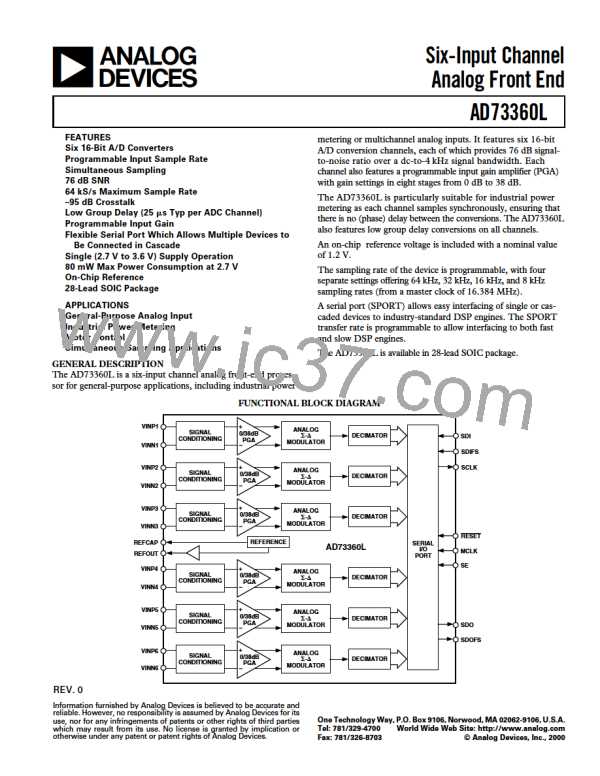AD73360L
DSP SPORT Interrupts
DSP
MICROPROCESSOR
If SPORT interrupts are enabled, it is important to note that the
active signals on the frame sync pins do not necessarily corre-
spond with the positions in time of where SPORT interrupts are
generated.
I
I
V
C
C
DAC
DAC
TORQUE & FLUX
CONTROL LOOP
CALCULATIONS
THREE-
PHASE
MOTOR
V
B
B
DRIVE
CIRCUITRY
I
V
A
A
On ADSP-21xx processors, it is necessary to enable SPORT
interrupts and use Interrupt Service Routines (ISRs) to handle
Tx/Rx activity, while on the TMS320CSx processors it is pos-
sible to poll the status of the Rx and Tx registers, which means
that Rx/Tx activity can be monitored using a single ISR that
would ideally be the Tx ISR as the Tx interrupt will typically
occur before the Rx ISR.
DAC
ISOLATION
AMPLIFIERS
TORQUE
SETPOINT
FLUX
SETPOINT
V
V
IN1
IN2
AD73360L
TRANSFORMATION
TO TORQUE &
FLUX
V
IN3
APPLICATIONS EXAMPLES
Vector Motor Control
CURRENT
V
IN4
COMPONENTS
V
IN5
The current drawn by a motor can be split into two compo-
nents: one produces torque and the other produces magnetic
flux. For optimal performance of the motor, these two compo-
nents should be controlled independently. In conventional
methods of controlling a three-phase motor, the current (or
voltage) supplied to the motor and the frequency of the drive are
the basic control variables. However, both the torque and flux
are functions of current (or voltage) and frequency. This cou-
pling effect can reduce the performance of the motor because,
for example, if the torque is increased by increasing the fre-
quency, the flux tends to decrease.
V
IN6
VOLTAGE
ATTENUATORS
Figure 30. Vector Motor Control Using the AD73360L
Industrial Power Metering
The AD73360L can be used to measure the voltage and current
in all three phases of a three-phase supply. The simultaneous
sampling architecture of the AD73360L is ideal for this applica-
tion where simultaneous sampling is critical to maintaining the
relative phase information between the three voltage and three
current phases. Figure 31 shows a block diagram of a three-
phase metering system. The VIN1, VIN2, and VIN3 channels are
used to measure the voltages in each phase (via voltage attenua-
tors). The current flowing in each phase can be detected by the
use of current-sensing isolation amplifiers, transformers or
Hall-effect sensors. VIN4, VIN5, and VIN6 are used to digitize
this information. A DSP microprocessor is used to perform
the mathematical calculations on the information provided
by the AD73360L.
Vector control of an ac motor involves controlling phase in
addition to drive and current frequency. Controlling the phase
of the motor requires feedback information on the position of
the rotor relative to the rotating magnetic field in the motor.
Using this information, a vector controller mathematically trans-
forms the three-phase drive currents into separate torque and
flux components. The AD73360L, with its six-channel simulta-
neous sampling capability, is ideally suited for use in vector
motor control applications.
I
V
C
A block diagram of a vector motor control application using the
AD73360L is shown in Figure 30. The position of the field is
derived by determining the current in each phase of the motor.
VIN1, VIN2, and VIN3 of the AD73360L are used to digitize this
information.
C
3
I
V
B
THREE-
PHASE
SUPPLY
B
2
I
V
A
A
1
Simultaneous sampling is critical to maintain the relative phase
information between the channels. A current-sensing isolation
amplifier, transformer or Hall-effect sensor is used between the
motor and the AD73360L. Rotor information is obtained by
ISOLATION
AMPLIFIERS
V
V
IN1
measuring the voltage from the three inputs to the motor. VIN4
IN5, and VIN6 of the AD73360L are used to obtain this informa-
,
IN2
V
AD73360L
V
DSP
MICROPROCESSOR
tion. A DSP microprocessor is used to perform the mathematical
transformations and control loop calculations on the informa-
tion fed back by the AD73360L.
IN3
V
V
V
IN4
IN5
IN6
VOLTAGE
ATTENUATORS
Figure 31. Three-Phase Power Metering
–24–
REV. 0

 ADI [ ADI ]
ADI [ ADI ]